We arrived in the desert town of San Pedro de Atacama (altitude 2,436m) after another early start and unpleasant airport experience. Here we are back in wasteland again! This time we are in luxury, staying at a relatively new hotel called Alto Atacama, 3km north of San Pedro in Pukara de Quitor which is home to a pre-Inca fortress. The hotel is embedded deep within a rich red valley and is extremely well camouflaged in its environment. Both the hotel and the staff are fabulous, where they simply cannot do enough for us.
The humidity in the area is just 4% which contributes to a clear atmosphere with wonderful light and clear night skies. I had imagined that one desert would be much like any other but this place proves me wrong all ends up. It is a centre for activities that we have not yet encountered and is growing in popularity every year. The population here is a massive 2,000 but the locals are probably matched by the touristas. As with all these places that offer earth’s natural wonders you can sit on the sidelines and skim the surface or you can get stuck in and get your feet dusty. We have tried to stand away from the other visitors and experience the beauty of the area at first hand. It is rich in minerals – here they mine Lithium, supplying 40% of world demand, Potassium, Boric acid and Copper. The Copper mine is run by the Chinese (obviously) and is the deepest mine in South America delving over 1km into the bowels of the earth.
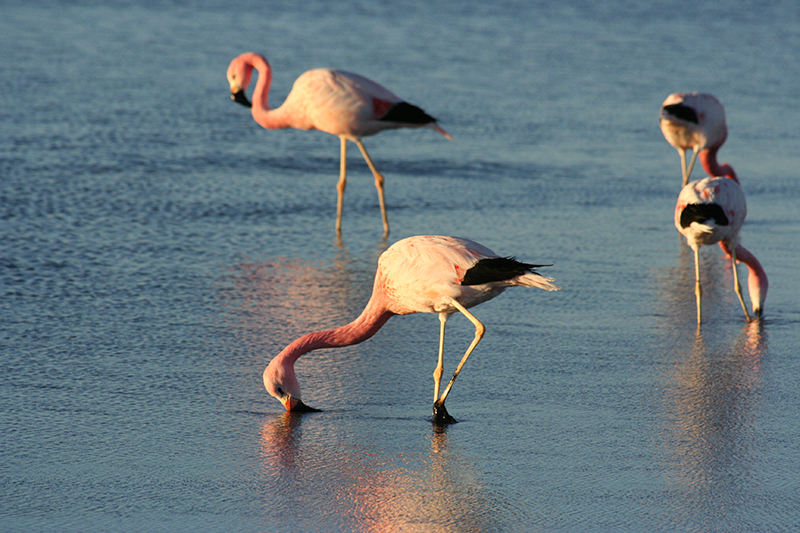 Salar de Atacama is a vast 3,000 sq km salt flat, and a surprise because they are not flat at all. They are fed by underground rivers and the salt sucks up the water that is rich in minerals forming uneven crunchy spikes. The pathways are a bit like walking through a UK town after snowfall with bright white powder interspersed with dirty sludge. The warm waters give birth to algae on which tiny, clear bodied shrimps feed. In turn, Flamingos eat the shrimp and provide a startling contrast to the white flatlands.
Salar de Atacama is a vast 3,000 sq km salt flat, and a surprise because they are not flat at all. They are fed by underground rivers and the salt sucks up the water that is rich in minerals forming uneven crunchy spikes. The pathways are a bit like walking through a UK town after snowfall with bright white powder interspersed with dirty sludge. The warm waters give birth to algae on which tiny, clear bodied shrimps feed. In turn, Flamingos eat the shrimp and provide a startling contrast to the white flatlands.
One of the few small communities in the area is Toconao that sits on the eastern shore of the salar and all the houses are built of white volcanic stone, sillar, which gives the village a very different look and feel to San Pedro. 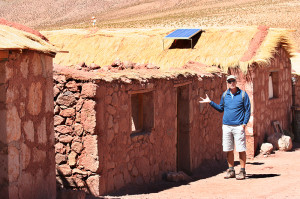 Machua, another tiny ‘community’ we visited, was like a ghost town. This village is a classic example of bureaucracy gone mad. The derelict place was given a total re-fit including solar panels for heating; however the local area cannot support any size of community as there is no agricultural land. It emerges that most of the homes are now ‘second homes’ to those who now come in to sell goods to the visitors passing through. There are a few valiant farmers who work the lands and raise llamas, sheep and goats. Interestingly all the llamas are tagged and owned by the farmers, whereas the ‘vicunas’ who are a wild Andean llama, always beige in colour, are not identified in any way therefore the numbers are known. Both llamas and vicunas are able to live side by side, neither being a territorial animal. Another wild animal rare to see but we found one bounding across the plains is the fox, usually very shy and staying well away.
Machua, another tiny ‘community’ we visited, was like a ghost town. This village is a classic example of bureaucracy gone mad. The derelict place was given a total re-fit including solar panels for heating; however the local area cannot support any size of community as there is no agricultural land. It emerges that most of the homes are now ‘second homes’ to those who now come in to sell goods to the visitors passing through. There are a few valiant farmers who work the lands and raise llamas, sheep and goats. Interestingly all the llamas are tagged and owned by the farmers, whereas the ‘vicunas’ who are a wild Andean llama, always beige in colour, are not identified in any way therefore the numbers are known. Both llamas and vicunas are able to live side by side, neither being a territorial animal. Another wild animal rare to see but we found one bounding across the plains is the fox, usually very shy and staying well away.
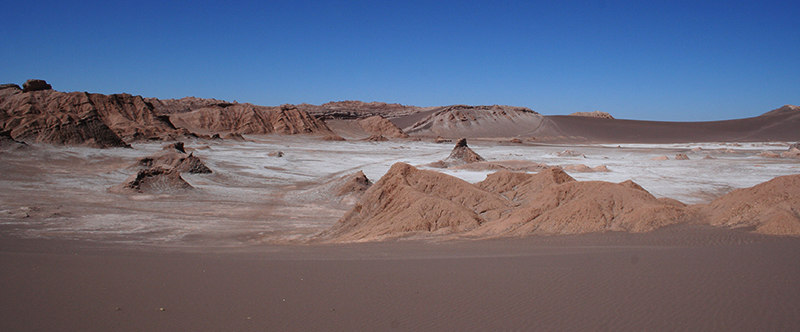 Not far away, as if it cannot be in the same area, the Valle de la Luna has a fantastic landscape caused by the erosion of salt mountains that is so named because it reflects the surface of the Moon. It has steep sand dunes, soft, sheer rock hills that have flat, dry river beds winding between them and salt and Gypsum crystals that glint in the sunlight. Our trek wanders through the landscape offering many wonderful views from vantage points at the highest locations and the clear, dry air completely robs us of our sense of distance. Objects that look close by are, in fact, many times further away than we estimate and this must be the most fun trek we have completed so far.
Not far away, as if it cannot be in the same area, the Valle de la Luna has a fantastic landscape caused by the erosion of salt mountains that is so named because it reflects the surface of the Moon. It has steep sand dunes, soft, sheer rock hills that have flat, dry river beds winding between them and salt and Gypsum crystals that glint in the sunlight. Our trek wanders through the landscape offering many wonderful views from vantage points at the highest locations and the clear, dry air completely robs us of our sense of distance. Objects that look close by are, in fact, many times further away than we estimate and this must be the most fun trek we have completed so far.
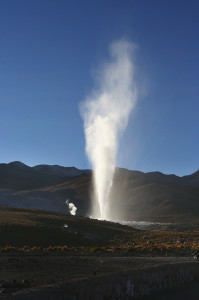 Again, providing another astonishing contrast are the El Tatio geysers, the highest in the world, which lie higher up in the mountains at 4,500m in the foothills of one of the active volcanoes, Putana. Our visit is at dawn when the hot, boiling water leaping into the sub zero atmosphere, provides the most spectacular aquatic display. We have to leave the hotel at 5.00am and I walk into the reception wearing my desert rats amongst much sniggering from other guests. The guides cannot hold themselves back:
Again, providing another astonishing contrast are the El Tatio geysers, the highest in the world, which lie higher up in the mountains at 4,500m in the foothills of one of the active volcanoes, Putana. Our visit is at dawn when the hot, boiling water leaping into the sub zero atmosphere, provides the most spectacular aquatic display. We have to leave the hotel at 5.00am and I walk into the reception wearing my desert rats amongst much sniggering from other guests. The guides cannot hold themselves back:
‘Hey, Eenglish! I think you should wear trousers not shorts. It is minus 10c up there!’
‘It’s always minus 10c in England.’ I reply rather feebly. I cannot possibly go and change now, even though I want to. I cannot let them think that the Brits are a gutless, soft centred bunch.
Tragically the power of the geysers has been diminished thanks to an Italian company who, whilst attempting to harness the geothermic muscle of the underground aquifers, has managed to drill a hole in one of the main waterways. The result is an enormous sprout of boiling water, 70m high that roars with indignation. The Italians have thrown themselves into reverse and beaten a hasty retreat leaving others to wonder how to repair the damage. They have left behind a furious local community who are desperate to seek retribution for damage to one of their main tourist sites. Tourism is the main economy here for the barren salt flats, the desert and the volcanic mountains and the altiplanic plains offer little in the way of a farming economy.
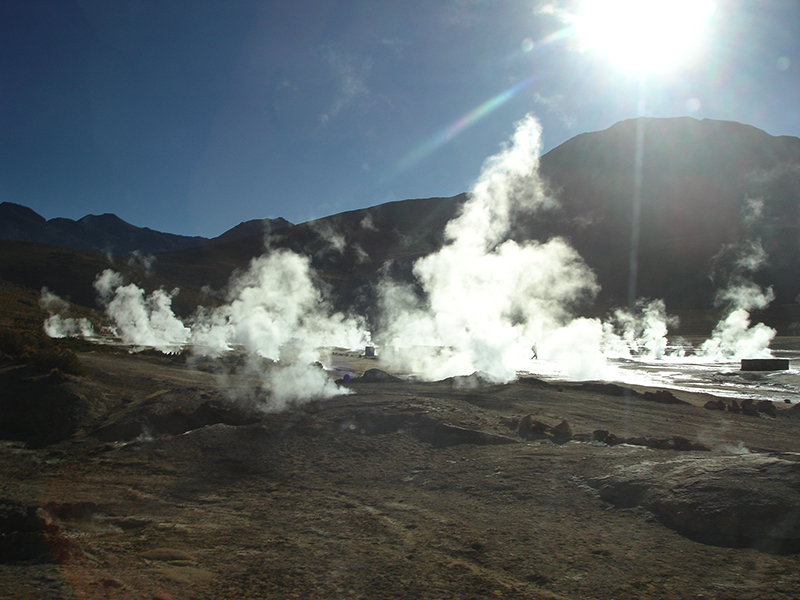 Nonetheless, the ‘natural’ geysers provide an astonishing spectacle. Hot vapours rise from the ground and somewhere amongst the billowing steam, water boils away or shoots skywards. The water boils at 85c at this altitude but it is still far too hot to stick a hand into, as we discovered to our cost. There is a constant presence of sulphur in the air and the ladies in the group claimed that was good for the skin, placing their faces over the top of some of the calcium chimneys formed from the rising water. Our guides, Matthias and Paulo, did not think this a good idea as the water can erupt unexpectedly from underground and, indeed, some people have been killed here by the geysers. Perhaps a new dangerous sport for the stupid? On our return we can clearly see fumaroles coming out of volcano Putano.
Nonetheless, the ‘natural’ geysers provide an astonishing spectacle. Hot vapours rise from the ground and somewhere amongst the billowing steam, water boils away or shoots skywards. The water boils at 85c at this altitude but it is still far too hot to stick a hand into, as we discovered to our cost. There is a constant presence of sulphur in the air and the ladies in the group claimed that was good for the skin, placing their faces over the top of some of the calcium chimneys formed from the rising water. Our guides, Matthias and Paulo, did not think this a good idea as the water can erupt unexpectedly from underground and, indeed, some people have been killed here by the geysers. Perhaps a new dangerous sport for the stupid? On our return we can clearly see fumaroles coming out of volcano Putano.
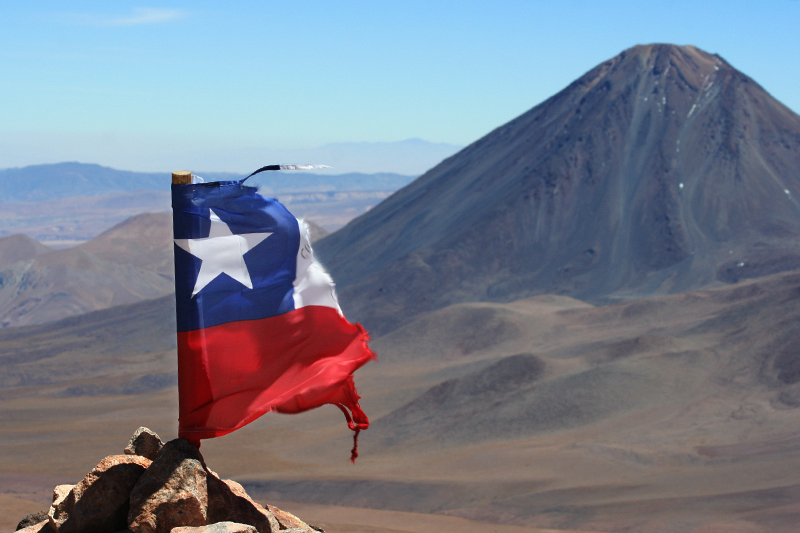 Our last outing was to climb the Cerro Toco, a ‘quiet’ volcano the summit of which stands at 5,800m above sea level (18,200 feet in ‘real money’). I can hardly believe that Debbie has talked me into another lung buster but it will be the first volcano we have climbed to the very top. It involves putting on all our warmest clothes including long johns and vests and large amounts of sunblock. Having spent so much time at altitude, we should be reasonably acclimatised but it is still really hard on the lungs if not too taxing on the muscles. We move at a snail’s pace with numerous stops to allow the poor old heart to stop pounding but, apart from James feeling light headed (nothing new there!) on a couple of occasions, we reach the top in a less shambolic state then in the past.
Our last outing was to climb the Cerro Toco, a ‘quiet’ volcano the summit of which stands at 5,800m above sea level (18,200 feet in ‘real money’). I can hardly believe that Debbie has talked me into another lung buster but it will be the first volcano we have climbed to the very top. It involves putting on all our warmest clothes including long johns and vests and large amounts of sunblock. Having spent so much time at altitude, we should be reasonably acclimatised but it is still really hard on the lungs if not too taxing on the muscles. We move at a snail’s pace with numerous stops to allow the poor old heart to stop pounding but, apart from James feeling light headed (nothing new there!) on a couple of occasions, we reach the top in a less shambolic state then in the past. 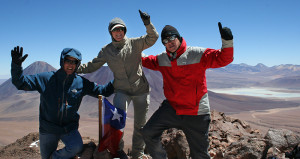 Neither of us have ever had our feet on terra firma at this height before and we feel a great sense of achievement as we stand on top of the world. In the clear, dry but very cold air we can see for miles in all directions. Our guide, Alvarro, points out the Lascar volcano, the most active in the region last erupting in 2007, and another volcano that we can see very clearly but is 150km away. We have fabulous views down onto the Atacama salt flats, the ‘white lagoon’, the high plains that we have travelled through when visiting the geysers. We can see into Chile, Bolivia and Argentina as all three borders meet 20km from where we stand. To the East we can see the Bolivian salt flats, where we will be tomorrow, that stretch away to the horizon. There is very little precipitation in this part of the World and the peaks of the Andes are clear of snow as they frame the pictures in every direction. The views are completely absorbing and we spend 40 minutes soaking it all up whilst trying to keep warm. In contrast, the descent is a breeze as we step down into warmer, oxygenated (comparatively!) air.
Neither of us have ever had our feet on terra firma at this height before and we feel a great sense of achievement as we stand on top of the world. In the clear, dry but very cold air we can see for miles in all directions. Our guide, Alvarro, points out the Lascar volcano, the most active in the region last erupting in 2007, and another volcano that we can see very clearly but is 150km away. We have fabulous views down onto the Atacama salt flats, the ‘white lagoon’, the high plains that we have travelled through when visiting the geysers. We can see into Chile, Bolivia and Argentina as all three borders meet 20km from where we stand. To the East we can see the Bolivian salt flats, where we will be tomorrow, that stretch away to the horizon. There is very little precipitation in this part of the World and the peaks of the Andes are clear of snow as they frame the pictures in every direction. The views are completely absorbing and we spend 40 minutes soaking it all up whilst trying to keep warm. In contrast, the descent is a breeze as we step down into warmer, oxygenated (comparatively!) air.
I want to add one grumble! The Chilean border post is at San Pedro de Atacma, a mere 40km from the border post with Bolivia that is stationed at their national boundary. How absurd! This is an ideal space for smuggling illegal fruits and whatever you like and underlines perfectly the stupidity of the ridiculous stance that the idiots at Santiago airport took. Nuff sed!

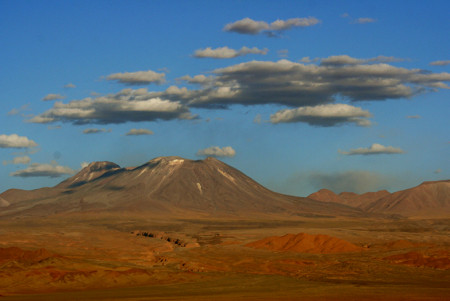
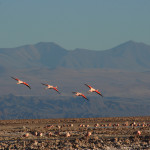
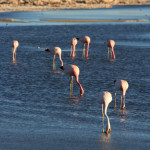
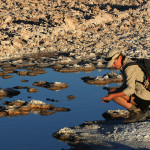
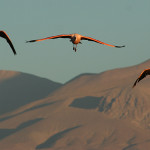
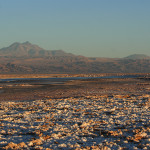
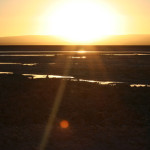
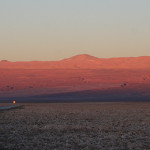
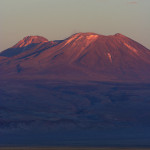
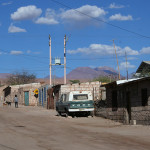
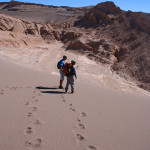
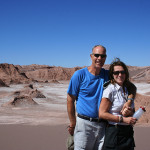
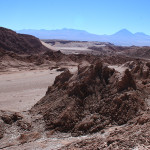
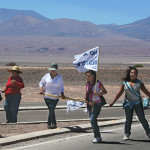
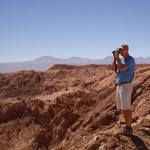
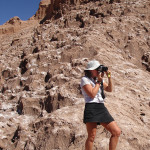
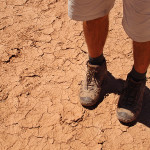
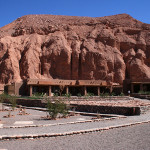
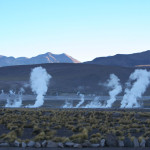
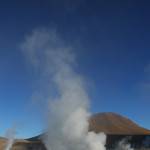
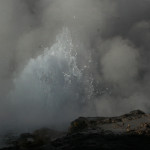
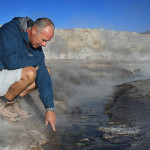
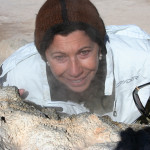
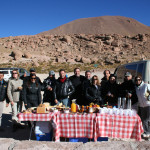
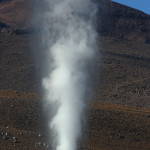
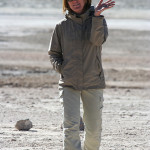
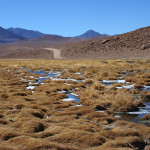
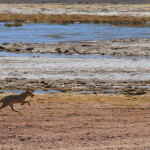
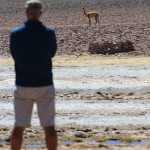
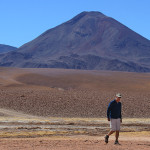
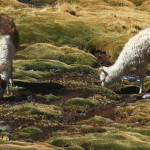
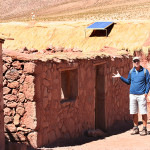
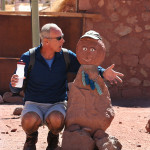
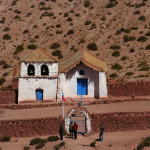
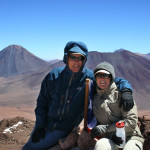
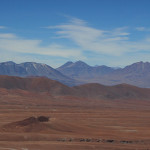
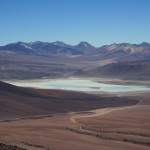
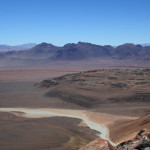
No comments yet.